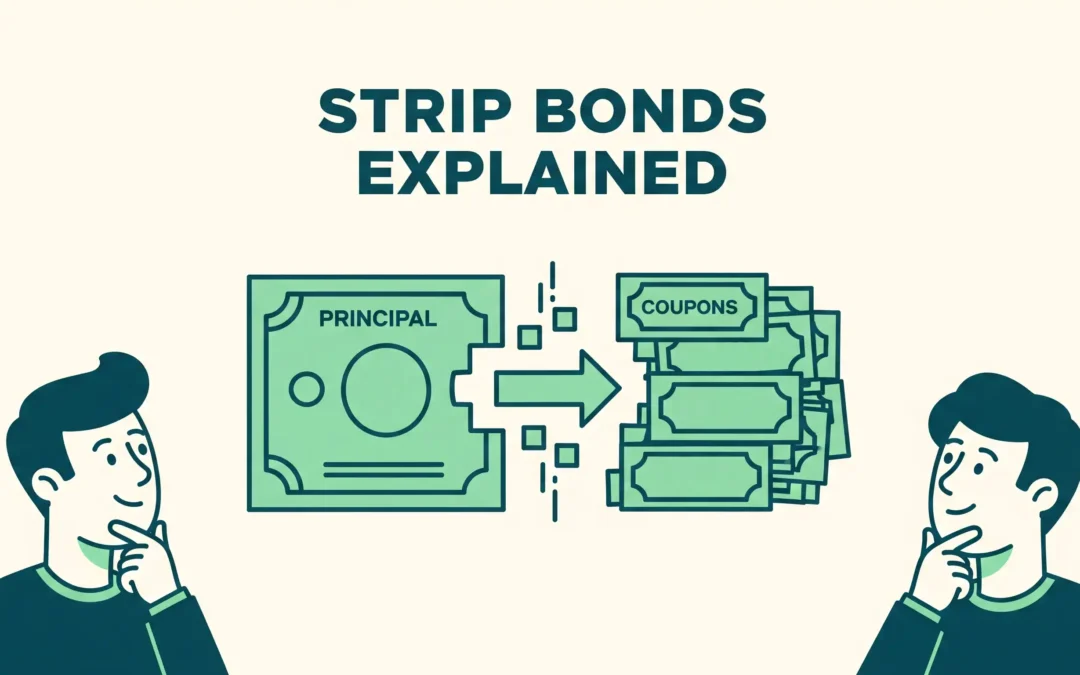There are different bonds available in the market, offered by the government and other organizations. Strip bonds ensure payment after the maturity and not in between. They are often confused with another popular bond, zero-coupon bonds. But are they similar or the same? If not, what is the difference between them?
Before answering all these questions, let us first understand the meaning of strip bonds. This article will help you understand the features, pros, and cons, along with a clear distinction from zero-coupon bonds.
What is a Strip Bond?
One kind of bond that doesn’t pay regular interest (coupon) over the course of its life is a strip bond. The term “strip” refers to the process of removing the bond’s interest payments, leaving only the principal payment. They are created by stripping the coupons and principal from existing bonds and are sold at a discount, then redeemed at face value upon maturity.
It’s a straightforward investment that appeals to people who want a guaranteed amount when redeemed for retirement or paying college costs.
Key Features:
- No interest payout: There is no income for the investor during the duration of the bond.
- Discounted: Purchased at a discount price and redeemed at the full value later.
- Maturity: Only the maturity amount is given as a payout at the end of the duration.
- Issuer body: Strip bonds are created from existing government or institutional bonds, typically by central banks or depositories, not directly issued themselves.
- Longer tenure: The tenure is on the longer side, usually between five to thirty years.
How Is a Strip Bond Different from a Zero-Coupon Bond?
There may be a misunderstanding about strip bonds and zero-coupon bonds. Let us understand their difference by the way they work:
Working of a Strip Bond:
- The principal and each interest payment are separate parts of a conventional bond (with coupons).
- These parts are “stripped” and offered for sale as distinct zero-coupon securities.
- Investors have two options:
- Future interest payments are represented by coupon strips.
- The principal strip is the face value paid at maturity.
- The bondholder receives a single payout at maturity after purchasing the strip at a steep discount.
- It is frequently developed by government organisations (such as the U.S. Treasury STRIPS or the RBI STRIPS in India).
Working of a Zero-coupon bond:
- It is issued with no interest or coupons, as specified earlier.
- The issuing price is less than its face value.
- During maturity, the investor gets paid the full face value.
- The investor makes money because of the difference between the purchase price and the maturity value.
- Issued directly by businesses or governments, such as long-term zero-coupon corporate bonds or certain sovereign bonds.
| Aspect | Strip Bond | Zero-Coupon Bond |
| Origin | Made by stripping coupons from bonds that already existed. | Directly issued as zero-coupon bonds |
| Structure | Coupons and principal sold as separate securities | No coupons included from the start |
| Issuer Example | RBI STRIPS (India), US Treasury STRIPS | Treasury Bills, certain corporate bonds |
| Market Nature | Secondary market instruments | Primary and secondary market instruments |
| Flexibility | Investors can choose only the coupon or principal strips | Sold as one complete zero-coupon security |
Pros and Cons of Strip Bond
Let us focus on the pros and cons to understand whether investing in strip bonds is a good idea or not.
Pros:
- Guaranteed payout: You are certain of the amount and timing of your payout.
- No risk of reinvestment: You are not concerned about reinvesting at lower rates because there are no periodic coupons.
- Perfect for long-term objectives: Excellent for retirement, marriage, or schooling planning where quantity and timing are crucial.
- Minimal credit risk (if issued by the government): particularly secure if issued by the central government or the RBI.
Cons:
- Income-free until maturity: Not appropriate if you require consistent cash flows.
- High interest rate sensitivity: The market value of your bond declines more than that of ordinary bonds when interest rates rise.
- Limited liquidity: It might be more difficult to sell before maturity on the secondary market.
- Implications for taxes: According to the accrual accounting method, the annual accrued gain in India may be subject to taxes even if you haven’t received it.
Bottomline
The conclusion can be drawn that all the strip bonds are zero-coupon bonds, but not all zero-coupon bonds are strip bonds. Strip bonds are named for the process in which a conventional bond is split into multiple separate securities, each representing a single coupon (interest) payment or the principal repayment. Each of these is sold at a discount and redeemed at face value on its maturity date. They have their pros and cons, like a sure payout at maturity, but with limited liquidity.
The investor must conduct research to determine if strip bonds align with their investing objective or not.


